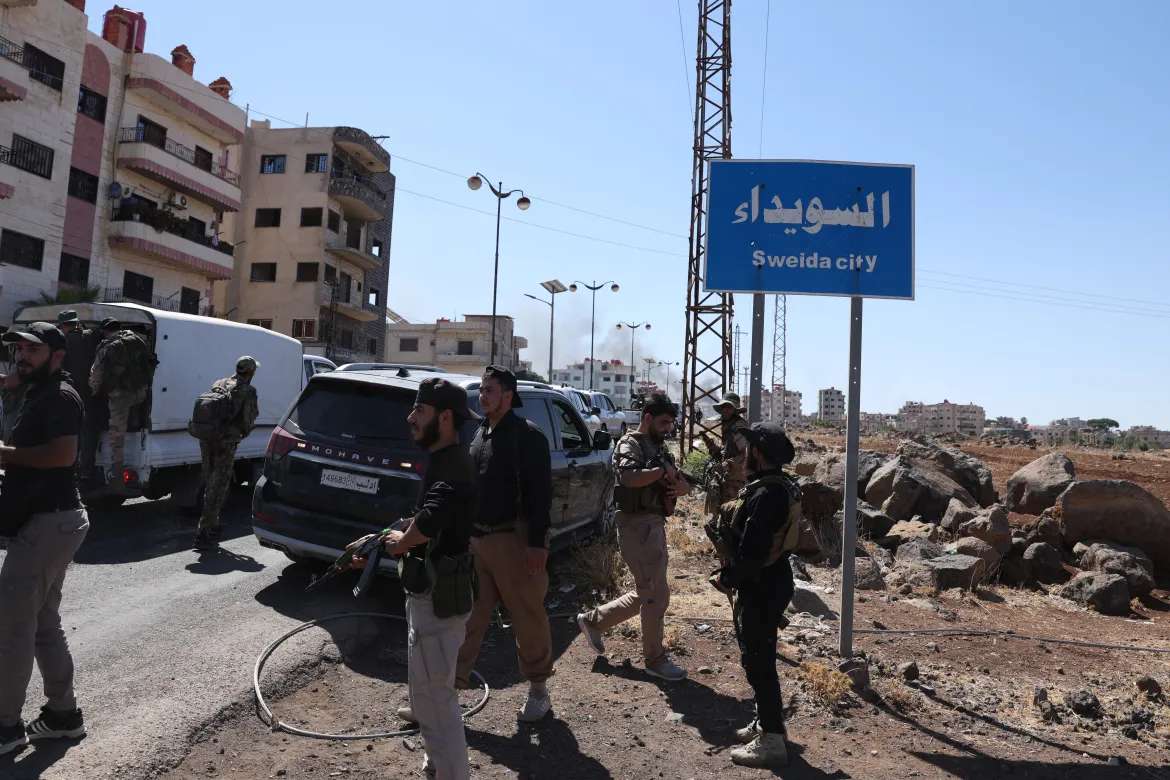No sooner had the dust of the Syrian war settled and Bashar al-Assad’s regime fallen in late 2024 than southern Syria exploded anew—this time with an openly sectarian character and unmistakable regional reverberations. Suwayda Province—the historical stronghold of the Druze sect—has transformed from a relatively safe haven into a complex battleground where local calculations intersect with regional minefields. What began as a tribal clash between Druze factions and Bedouin groups over kidnapping and revenge operations quickly spiraled into comprehensive armed conflict, opening all fronts simultaneously.
As-Suwayda was not isolated from the profound transformations that occurred in the Syrian landscape in recent months. After the collapse of the central regime, power was assumed by a new transitional government headed by Mohammed al-Shara. Despite the government’s attempts to impose security in the south, the deployment of military units to the city was met with rejection from a broad segment of the local community, particularly traditional Druze leaders, who viewed the move as a form of disguised hegemony rather than public order maintenance.
The confrontations that erupted in mid-July soon took on a more violent character, opening the door to unprecedented Israeli intervention. In a precedent unseen in Syrian geography for decades, Tel Aviv launched airstrikes against units affiliated with the new Syrian army, declaring it was acting to protect Druze in both the Golan and As-Suwayda. While official Israeli discourse employed the language of sectarian protection, the ground reality suggested something deeper: direct intervention to establish new red lines in southern Syria during a moment of regional strategic vacuum.
Beyond the rhetoric, Israel was sending explicit multi-directional messages. First, to the new Syrian government: that it would not permit any military approach toward the Golan borders, regardless of who rules Damascus. Second, to the Druze within its borders: that Israeli protection is not limited to political boundaries but extends wherever allegiance reaches. Third, and perhaps most importantly, to the international community: that the balance of power in southern Syria cannot be drawn without accounting for Israel’s position, role, and national security.
However, the Druze interior was not a monolithic bloc. Opinion was divided between those who saw the new government as threatening Syrian pluralism and those who viewed the greater danger as coming from outside rather than within. Between these two sides, civilians found themselves trapped between Israeli aircraft missiles and national army tanks, in a scene reminiscent of the tragedy of border cities in collapse wars.
Despite the ceasefire declaration on July 15, the hours-long truce did not hold. Clashes resumed, and Israeli airstrikes continued at an escalating pace, targeting Syrian military positions in the As-Suwayda countryside and extending to some locations around Damascus. The new Syrian government, attempting to rebuild public trust, found itself in a harsh test: between establishing internal security and confronting superior external intervention that disregards sovereignty and does not recognize its full legitimacy.
What is happening in As-Suwayda is not merely a tribal explosion but a living test of the post-Assad state’s fragility. The conflict is no longer confined between Druze and Bedouins, nor between government and militants, but between contradictory political maps: between those who want a unified, centralized Syria and those who see the solution in local administration and distinct identities, and between those seeking to reshape the state and those hastening its dismantlement in the name of sects, security, or deterrence.
The Israeli entity, for its part, acts with clarity: it wants borders without armies, Syria without an army, and a south without central decision-making. With the retreat of direct Iranian influence after Assad’s regime fell and Hezbollah’s reduced ability to use Syrian territory as strategic depth, the entity assumed the threat had diminished. But absence does not equal reassurance. The Israeli entity is moving preemptively to secure its superiority and is rewriting the rules of engagement—this time not only against the “axis of resistance” but against anyone possessing organized weapons outside the deterrence arrangements it imposes itself.
Despite the ceasefire declaration on July 15, ground realities revealed its fragility. Clashes resumed on Wednesday morning, July 16, with confrontations extending to the city’s outskirts, while the Israeli entity launched new airstrikes on Syrian army positions in the As-Suwayda and Damascus countrysides, citing continued sectarian tension and border security threats. This dual escalation—internal and external—reignited the crisis and confirmed that southern Syria remains a candidate for explosion at any moment unless properly controlled politically and security-wise before matters slip from everyone’s hands.
As for Syria—emerging from the furnace of destruction—it stands at a crossroads: either rebuild the state on a new foundation of partnership and balance, or slide into a narrow corridor of mobile conflicts, where every sect becomes an island, every province a front, and every alliance tied to international positions rather than local consensus.
As-Suwayda has revealed that Assad’s fall was not the end of wars but the beginning of exposing the deep structure of the Syrian crisis: a structure based on mutual suspicion, fear of the center, and seeking strength from abroad. Will the new Syria learn from the lessons of blood? Will it emerge from the cloak of “imposed legitimacy” to the legitimacy of national consensus? Will the Israeli entity’s messages end at the borders of bombardment, or will we see it holding the south’s strings in the name of permanent deterrence?


